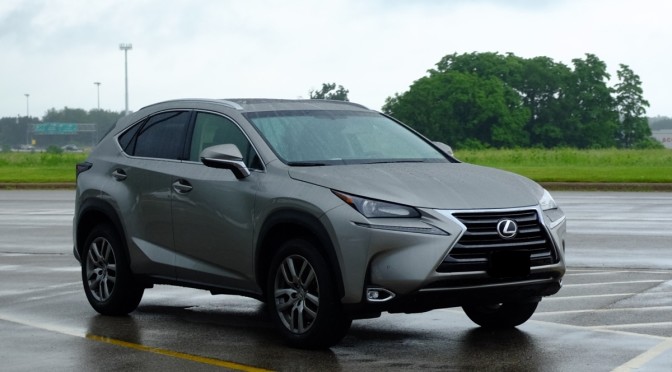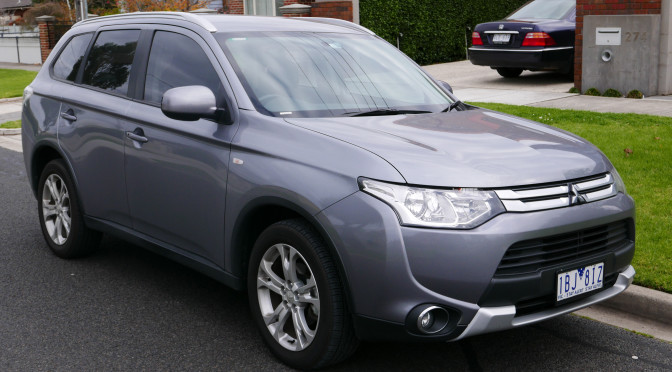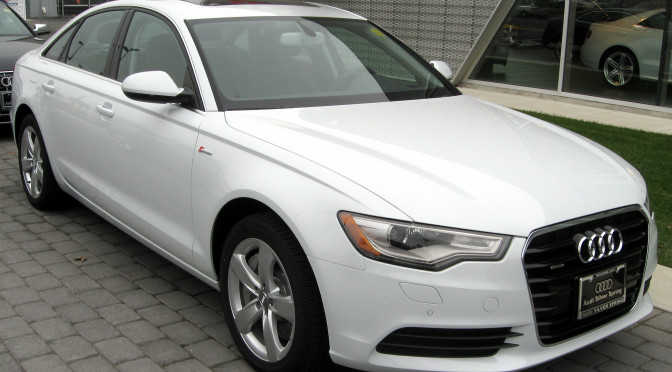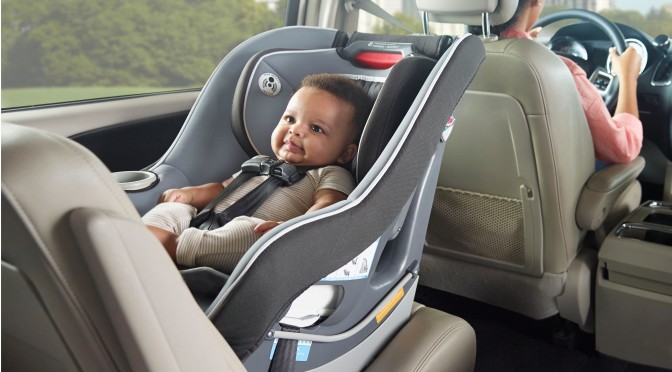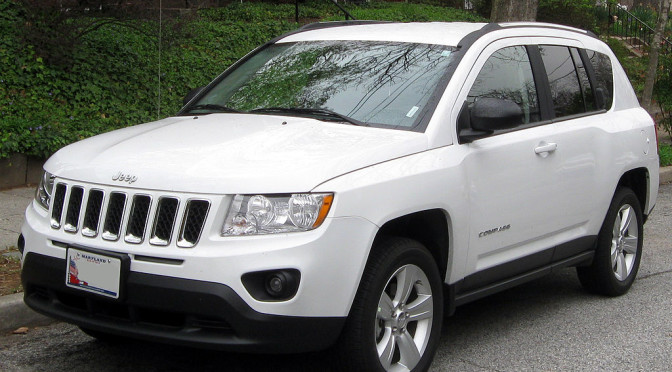The Lexus NX, or “Nimble Crossover,” is Lexus’ newest offering to the growing compact luxury crossover market, and is a small and sleek SUV with an impressive array of safety features. It features good frontal overlap scores, good side scores and roof scores, and even comes with front crash prevention systems in higher trim levels. Classified by the IIHS as a mid-sized luxury SUV, the NX competes with more established offerings in the 5-passenger luxury crossover market like the Volvo XC60, BMW X3, Acura RDX, Audi Q5, Mercedes-Benz GLK-Class, and its larger stablemate, the Lexus RX, among families interested in transporting up to 5-passengers without the heft and length of a 3-row luxury vehicle.
Because luxury-minded parents of small children are likely to cross shop the NX with the aforementioned SUVs, I wanted to see how competitive it was from a 3 across standpoint. In other words, how easy is it to install 3 car seats across the back row of a Lexus NX? Is it even possible, given the NX’s platform similarities to the Toyota Rav4, a vehicle notorious for overlapping seat belts and impossible 3 across installations?
Unfortunately, it’s not. I’ll go into why in a moment, as well as information on which options you do have for car seat installations in the NX. Before that, however, here are some best practice recommendations regardless of how many car seats you’re installing, and which vehicles you’re installing them inside.
The safest configuration we know of when it comes to vehicle safety is rear-facing. I recommend rear-facing your children long past age 1, which is the legal requirement in most states, and going well into the preschool years (ideally until 4!), before forward-facing them in harnessed convertible or combination seats (ideally until 8!). Once they outgrow their harnessed seats, it’s best to keep them restrained in high-back boosters until they’re physically and psychologically ready to use adult seat belt systems (which typically happens between 10 and 12). We want our little ones in the safest positions we know of for as long as possible to give them the greatest advantages in a collision.
Keeping these ideas in mind, I set to work to find which infant, convertible, combination, and booster seats would work best in 3 across combinations in the Lexus NX. It’s my goal to make this list the most thorough on the Internet. If you find the list helpful when shopping for car seats, you can shop through my Amazon link below. I’ll add more seats as I test them over time.
You can access the complete 3 across guide for every vehicle here and the complete list of recommended seats here. The Canadian car seat guide is here. 3 across car seat images are courtesy of yours truly.
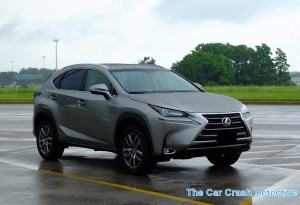 2015, 2016 Lexus NX
2015, 2016 Lexus NX
Guaranteed 3 across installations: None!
The Lexus NX is unfortunately not capable of safely installing 3 car seats across the back row, due to the ridiculously overlapping seat belts in the back seat between the center and driver’s side outboard seats. This is also the case with the Toyota Rav4, upon which the Lexus NX is based, and all signs point to this continuing to be a “feature” of the Rav4, despite Toyota’s continued insistence that it is a 5-person vehicle.
While overlapping seat belts in and of themselves don’t automatically exclude a vehicle from 3 across capabilities (the Highlander has overlapping belts but is still a decent 3 across vehicle, for example), when the belts overlap to a significant degree (as in the current generation Corolla, Rogue, or CX-5), 3 across becomes an impossibility for safety reasons. I’ve included 2 car seat arrangements that will work easily given the available space in the NX, but until Lexus corrects this, the NX will remain a 2-across vehicle.
Clek Fllo (x2).
Clek Foonf (x2).
Britax Advocate ClickTight (x2).
Britax Boulevard ClickTight (x2).
Britax Marathon ClickTight (x2).
Britax Advocate G4.1 (x2).
Britax Boulevard G4.1 (x2).
Britax Marathon G4.1 (x2).
Diono Rainier (x2).
Diono Pacifica (x2).
Diono Radian RXT (x2).
Diono Radian R120 (x2).
Diono Radian R100 (x2).
Graco Size4Me 65 (x2).
Graco Contender (x2).
Combi Coccoro (x2).
Tips and Tricks:
The current and only generation of the Lexus NX is 180 inches long and 73 inches wide, which means you’ll have a good amount of space for any 2 car seats, though not 3 (see above). Use your seat belts to get as much space as possible for the wider seats, and remember that you can only install 2 seats in the outboard positions (i.e., behind the driver and behind the passenger seats) or in the center and passenger outboard positions. You cannot install 2 seats at the driver and center positions due to the overlapping belt issue.
—
If you find the information on car safety, recommended car seats, and car seat reviews on this car seat blog helpful, you can shop through this Amazon link for any purchases, car seat-related or not. Canadians can shop through this link for Canadian purchases.
3 Across Installations: Which Car Seats Fit a Mitsubishi Outlander?
The Mitsubishi Outlander is, on paper, one of the safest small SUVs you can buy. It has good small overlap, moderate overlap, side, and roof scores, as well as a decent amount of front crash prevention technology available in optional trim packages. It’s also one of the few small SUVs on the market with a 3rd row option. It competes with a bevy of small and compact crossovers in the US market, including the Kia Sportage, Honda CR-V, Toyota RAV4, Nissan Rogue, Mazda CX-5, Subaru Forester, Ford Escape, Jeep Compass, Hyundai Tucson, and Jeep Patriot. In other words, it’s got company, which is part of why a number of parents might not know about it. But those who do tend to be quite loyal fans of the Outlander.
As a result, when I had the opportunity to look into the Outlander’s performance in puzzling 3 car seats across the back row (and a few extra in the 3rd row), I couldn’t pass it up. This 3 across guide covers several generations of the Outlander, and while it’s not as large of a list as I’d like it to be, it’s already the largest on the Internet. Before going into the car seats I was and wan’t able to squeeze into that back rows, let’s take a quick look at some basic elements of car seat safety, in terms of which seats to use and when in order to keep your kids as safe as possible while on the road.
The safest configuration we know of when it comes to vehicle safety is rear-facing. This goes for adults as well! Rear-face your infants, toddlers, and preschoolers for as long as possible (ideally until 4!), before forward-facing them in harnessed convertible or combination seats (ideally until at least 5 or 6!). Once they outgrow their harnessed seats, it’s best to keep them restrained in high-back boosters until they’re physically and psychologically ready to use adult seat belt systems (which typically happens between 10 and 12). We want our little ones in the safest positions we know of for as long as possible to give them the greatest advantages in a collision.
Keeping these ideas in mind, I set to work to find which infant, convertible, combination, and booster seats would work best in 3 across combinations in the Mitsubishi Outlander. It’s my goal to make this list the most thorough on the Internet. If you find the list helpful when shopping for car seats, you can shop through my Amazon link below. I’ll add more seats as I test them over time.
You can access the complete 3 across guide for every vehicle here and the complete list of recommended seats here. The Canadian car seat guide is here. 3 across car seat images are courtesy of Wikipedia.
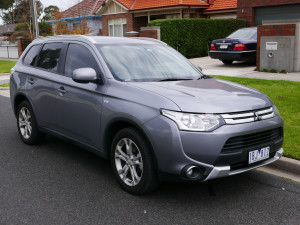 2013, 2014, 2015, 2016, 2017, 2018 Mitsubishi Outlander
2013, 2014, 2015, 2016, 2017, 2018 Mitsubishi Outlander
Guaranteed 3 across installations:
Clek Fllo (x3).
Clek Foonf (x3).
Clek Oobr (x3).
Peg Perego Flex 120 (x3).
Maxi-Cosi RodiFix (3).
Chicco KeyFIt 30 (x3).
Diono Radian RXT (x3).
Diono Radian R120 (x3).
Diono Radian R100 (x3).
Combi Coccoro (x3).
Clek Oobr (x2), Chicco KeyFIt 30.
Clek Fllo, Diono Radian / RXT, Diono Radian / RXT.
Tips and Tricks:
The current generation of the Mitsubishi Outlander is 183 inches long and 71 inches wide. This is on the longer end for a small SUV, but it’s also on the narrower end. And when you consider the fact that there’s a 3rd row squeezed in behind the 2nd, you quickly realize that you’re going to have more challenges fitting car seats into this vehicle than you’d like. However, let’s take a closer look at the pros and cons.
Good things about the current generation Outlander are that you can remove the head restraints if you need to, and that you can move the back row seats a bit forward and backward, which helps with leg room flexibility since you’re not dealing with a particularly long vehicle.
Bad things about the Outlander primarily involve the center seat in the 2nd row; it’s a very, very narrow one, and when you’ve got car seats in the outboard positions, it feels even narrower. The head restraint above this seat is also a short one. More importantly, there is a slight crossover between the buckle stalks in the center and those on the driver’s outboard side, which is often the kiss of death for car seat installations. The Radians, for example, will fit in that center position, but won’t fit as well as I’d like them to. Additionally, you can’t adjust the shoulder belt height in the 2nd row, which makes booster use more challenging than it should be.
The 3rd row goes from bad to worse. It’s better than the 3rd row in the 2nd gen Outlander, but it’s still hard to get to and you aren’t allowed to use any rear-facing seats there; everything’s got to be forward-facing, per the owner’s manual. This is almost certainly due to the short amount of space between the 2nd and 3rd row. Beyond that, you don’t have access to any top tether anchors in this row, which is significant when forward-facing tethering is important and since you’re pretty much only going to be forward-facing anyway. Oh, and you can’t sit there if you’re taller than 5’3″, per Mitsubishi. There’s also pretty much no leg room and the seat cushions are practically nonexistent. Don’t try to use the 3rd row with anyone but perhaps short kids and pre-teens in boosters. To be honest, they probably won’t be happy there either. However, it’s definitely possible to fit them there.
Because of the length of the vehicle, if you want to make the most of your money, I’d strongly recommend Radians due to the minimal amount of space they take up with angle adjusters; your legs and front-row passengers will thank you.
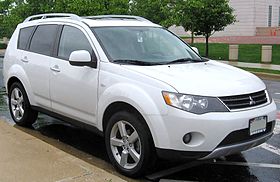 2007, 2008, 2009, 2010, 2011, 2012 Mitsubishi Outlander
2007, 2008, 2009, 2010, 2011, 2012 Mitsubishi Outlander
Guaranteed 3 across installations:
Clek Fllo (x3).
Clek Foonf (x3).
Clek Oobr (x3).
Peg Perego Flex 120 (x3).
Maxi-Cosi RodiFix (3).
Chicco KeyFIt 30 (x3).
Diono Radian RXT (x3).
Diono Radian R120 (x3).
Diono Radian R100 (x3).
Combi Coccoro (x3).
Clek Oobr (x2), Chicco KeyFIt 30.
Clek Fllo, Diono Radian / RXT, Diono Radian / RXT.
Tips and Tricks:
The second gen of the Mitsubishi Outlander is around 183 inches long and just under 71 inches wide, or just about the same as the 3rd generation. The fact that you can fit 7 passengers into a vehicle this length is impressive. However, when it comes to car seats, you’ll again have a narrow selection to choose from due to the narrowness of the vehicle and the nearly impossible-to-use center 2nd row seat (see the extended information in the write-up for the 3rd generation Outlander above). As before, use your seat belts for every installation; LATCH will rob you of extremely valuable real estate.
Once again, because of the length of the vehicle, if you want to make the most of your money, I’d strongly recommend Radians due to the minimal amount of space they take up with angle adjusters; your legs and front-row passengers will thank you.
—
If you find the information on car safety, recommended car seats, and car seat reviews on this car seat blog helpful, you can bookmark and shop through this Amazon link. Canadians can bookmark and shop through this link.
3 Across Installations: Which Car Seats Will Fit in an Audi A6?
The Audi A6 is one of the safest cars you can buy today in the US in two very important areas: side impact crash protection and driver death rates. To put it another way, nearly every other car on the road will crush more when t-boned than a current generation Audi A6, and the Audi A6 is also one of only four cars (along with its stablemate the Audi A4, the Mercedes E-Class sedan and Subaru Legacy) to have ever been estimated to have had zero driver deaths in a three year period by the IIHS. In other words, this is one of the safest cars you can buy.
With that said, it’s no surprise that the A6 competes favorably with other large luxury cars sold in the US, including the aforementioned Mercedes E-Class, BMW 5-Series and 7-series, and Volvo S80. It’s also chosen by a surprising number of families interested in luxury, style, and safety for spouses and little ones. To that end, I borrowed one from a friend to figure out how well it does when it comes to the practical and often frustrating task of fitting 3 car seats safely across the back seat. Before we go into which seats worked and which seats didn’t, it’s worth reviewing what kinds of seats are best for certain ages of kids.
First of all, infants, toddlers, and preschoolers are safest when rear-facing. I recommend rear-facing as long as you can (ideally until 4!), before forward-facing them in harnessed convertible or combination seats (ideally until 8!). Once they outgrow their harnessed seats, I suggest keeping them in high-back boosters until they’re physically and psychologically ready to use adult seat belt systems (which typically happens between 10 and 12). What we want to do is keep our kids restrained in the safest positions for as long as possible to increase their odds of surviving crash forces.
Keeping these ideas in mind, I set to work to find which infant, convertible, combination, and booster seats would work best in 3 across combinations in the Audi A6. I found several good options and a few great ones. If you find the list helpful when shopping for car seats, you can shop through my Amazon link below. I’ll add more seats as I test them over time.
You can access the complete 3 across guide for every vehicle here and the complete list of recommended seats here. The Canadian car seat guide is here. 3 across car seat images are courtesy of Wikipedia.
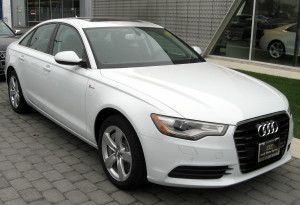 2012, 2013, 2014, 2015, 2016, 2017 Audi A6
2012, 2013, 2014, 2015, 2016, 2017 Audi A6
Guaranteed 3 across installations:
Clek Fllo (x3).
Clek Foonf (x3).
Graco Size4Me 65 (x3).
Chicco KeyFit 30, Clek Foonf, Chicco KeyFit 30.
Chicco KeyFit 30, Clek Fllo, Chicco KeyFit 30.
Combi Coccoro (x3).
Clek Fllo, Graco Contender, Diono Radian / RXT.
Clek Fllo, Diono Radian / RXT, Diono Radian / RXT.
Clek Fllo, Graco Contender, Graco Head Wise 70.
Clek Fllo, Graco Size4Me 65, Diono Radian / RXT.
Tips and Tricks:
The current generation of the Audi A6 is 194 inches long and 74 inches wide, which means you’re going to have an easier time with 3 across installations than you would in most other cars, including the E-Class sedan to which it’s frequently compared. You’ll want to use your seat belts on all three seats to get the most space, however, and leave LATCH for times when you’ve only got one or two seats to install.
If you’re looking for the most reliable seats to make 3 across work in the A6, and don’t want to struggle with scraped knuckles and difficult installations, I’d just go with 3 Fllos, 3 Foonfs, or 3 RXTs. They’re among the narrowest seats on the market and I’ve yet to find a vehicle that can’t make them work in 3 across setups. All of these seats can be used to rear-face from birth (the Fllos and Foonfs will require the Infant-Thingy insert to do so) until your kids weigh 50 pounds (45 with the Radians) and can then be turned forward-facing for additional time.
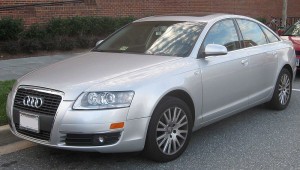 2005, 2006, 2007, 2008, 2009, 2010, 2011 Audi A6
2005, 2006, 2007, 2008, 2009, 2010, 2011 Audi A6
Guaranteed 3 across installations:
Clek Fllo (x3).
Clek Foonf (x3).
Graco Size4Me 65 (x3).
Chicco KeyFit 30, Clek Foonf, Chicco KeyFit 30.
Chicco KeyFit 30, Clek Fllo, Chicco KeyFit 30.
Combi Coccoro (x3).
Clek Fllo, Graco Contender, Diono Radian / RXT.
Clek Fllo, Diono Radian / RXT, Diono Radian / RXT.
Clek Fllo, Graco Contender, Graco Head Wise 70.
Clek Fllo, Graco Size4Me 65, Diono Radian / RXT.
Tips and Tricks:
The 2005-2011 generation of the Audi A6 is 194 inches long and 73 inches wide, or only 1 inch narrower than the succeeding generation. In other words, for 3 across purposes, the cars are going to be very similar in feasibility, although you’ll have an easier time in the following generation than you will in this one. As always, focus on seat belt installations and leave LATCH behind if your goal is to get all 3 seats to work together.
—
If you find the information on car safety, recommended car seats, and car seat reviews on this car seat blog helpful, you can shop through this Amazon link for any purchases, car seat-related or not. Canadians can shop through this link for Canadian purchases.
The Orphan Seat: 3 Huge Rear-Facing Advantages for Kids
“It’s a horrible term,” she said, “but E.M.T.’s call the rear-facing seat ‘the orphan seat’ because in a bad car accident, that child is often the only one who survives.” – Pediatrician at Morgan Stanley Children’s Hospital in New York.
I most recently wrote about the phenomenon of the orphan seat here, in the story of a Utah toddler, Lily, who survived a crash that killed her mother and left her hanging upside down in her car seat while the car she was trapped in lay half-submerged in a river. While her mother sadly passed away, Lily lived.
I’ve written about the orphan seat several more times in the past, and will continue to write about the phenomenon because I feel the need to continue to advocate for the use of the right car seats in the right ways at the right times, the importance of safe driving, and the value of choosing safe vehicles at any budget.
Of course, no parent wants to think of passing away in a severe car crash, but I can’t think of any parent who’d rather have their child pass away with them than have the chance to continue living, whether with the other parent, with grandparents or godparents, or with extended family. However, if we’re not rear-facing as long as we can, especially between birth and the preschool years, we’re placing our children at a severe disadvantage compared to what we know about what it takes to survive car collisions.
Current laws in the US only require children to rear-face until 1, except for in New Jersey, which leads the US with a minimum forward-facing requirement of 2 years. However, even New Jersey doesn’t go nearly far enough. In Sweden, as I’ve noted elsewhere, the standard is 4 years, and it’s considered as normal as rear-facing until 1 is here. As a result, they lose nearly no young children to car collisions each year. Let’s look at 3 excellent, science-based reasons to practice extended rear-facing.
3 big, science-based reasons to rear-face your kids past 1, 2, and 3
1. Children’s proportions are different from adult proportions.
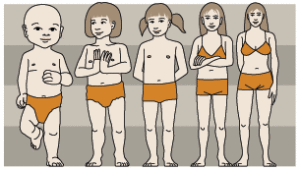 Look at the image on the left from the kind folks at Rear Facing in the UK. Most parents and people who work with very young children are aware of how disproportionately large infant heads are. However, most aren’t aware of how much of a change people go through from infancy to adulthood. A 9-month old’s head alone is 25% of his or her weight. The head of an adult, in contrast, is only 6% of his or her weight.
Look at the image on the left from the kind folks at Rear Facing in the UK. Most parents and people who work with very young children are aware of how disproportionately large infant heads are. However, most aren’t aware of how much of a change people go through from infancy to adulthood. A 9-month old’s head alone is 25% of his or her weight. The head of an adult, in contrast, is only 6% of his or her weight.
What this means is that proportionally speaking, a child’s head is quite relatively compared to the rest of his or her body, and as a result, in a collision, the child’s neck must deal with that proportionally greater strain. To put it even more simply, if a 160-pound woman had the proportions of a baby, her head would weigh 40 pounds and her neck would be a lot more likely to break in much milder collisions than those normal adults could walk away from.
Rear-facing distributes the tremendous forces of a crash through a child’s head, neck, and back, via the car seat behind the child’s head, neck, and back. Forward-facing concentrates those forces into the neck.
2. One quarter of an inch is all it takes to paralyze a child.
Along the same lines, the spinal cord of a child is encased within a spine and skeleton that continue to grow and that aren’t made of hard bones yet. There’s lots of cartilage (the same material our noses and ears are made of) peppered throughout. As a result, in a crash where a child is forward-facing, all that energy that flings his or her disproportionately large head forward gets concentrated into the neck area, which can stretch (due to inertia, or why we’re thrown forward into our seat belts when braking suddenly). It can stretch significantly. If it stretches the spine more than 1/4th of an inch, it snaps. That’s all it takes to paralyze or kill a child.
When rear-facing, that traumatic stretching is much, much, much, much, much (5x, actually) less likely to occur.
3. Their rib cages bend instead of snap.
A third science-based reason to keep rear-facing has to do with the thoracic cavity, or the chest. Because kids have lots of cartilage instead of solid bone, their rib cages also behave differently than ours–than those of adults. The function of the rib cage is to protect the heart and lungs, as well as a few additional organs. The heart and lungs are the biggest ones, however. This is why our ribs are designed to crack, as painful as it may be, as a way of absorbing what could otherwise be a life-ending amount of energy coming toward our chests. However, children’s rib cages have much more cartilage than ours do (we still have some to help our ribs move when we breathe), which means that when pressed against a harness in a forward-facing collision, the ribs are much more likely to press into our soft internal organs, which can easily lead to severe internal trauma and death.
When rear-facing, of course, that harness-to-rib force is much less likely to occur since the chest is moving away from the harness and toward the back of the seat in a collision. In other words, it’s much safer.
No parent wants to leave this world while their children are young, and especially in such a tragic way as through a car crash. But I also don’t know of any parents who’d rather their children left this world before they did because they weren’t safely restrained. Right now, the dominant US approach to car seat safety is wrong, whether in terms of the laws on the books or in people’s perspectives and beliefs. If you’re reading this blog, you know it’s important to go beyond the minimum to keep your children and family safe, and it’s my hope that the more of us there are, the quicker we can spread the word about the importance of extended rear-facing, safe driving, and a sustainable approach to road safety that leaves everyone safer.
Mike, you’ve convinced me to rear-face past 1, 2, and even 3. Now help me do it! What are good seats for extended rear-facing until 4 or 5 (or until Kindergarten!)?
Things have never been better in terms of ERF potential here in the United States. I’ve reviewed dozens of seats that will let your kids rear-face until 40, 45, or 50 pounds here, but here are my absolute favorites at the moment:
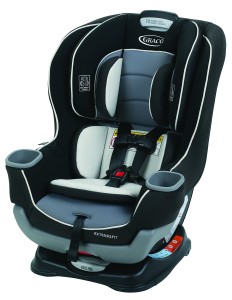 Under $200, I think the best convertibles on the market right now are the Graco Extend2Fit, Safety 1st Grow and Go EX Air, and Safety 1st Advance EX 65+ Air+. The three seats are very similar, with the main differences including widths and whether they include additional booster modes or not. All of these seats are designed to be used from the day your child leaves the hospital until the day s/he weighs 50 pounds. They have among the highest height limits on the market, which means that just about any child will be able to use them until at least turning 6. Lighter children may get additional time out of them past 7!
Under $200, I think the best convertibles on the market right now are the Graco Extend2Fit, Safety 1st Grow and Go EX Air, and Safety 1st Advance EX 65+ Air+. The three seats are very similar, with the main differences including widths and whether they include additional booster modes or not. All of these seats are designed to be used from the day your child leaves the hospital until the day s/he weighs 50 pounds. They have among the highest height limits on the market, which means that just about any child will be able to use them until at least turning 6. Lighter children may get additional time out of them past 7!
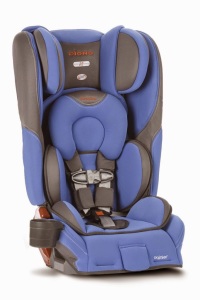 Under $300, my favorite convertibles on the market right now are the Diono Rainier and the (now discontinued) Diono Pacifica. Again, both seats are almost identical; the main difference lies in the head wings present in the Rainier, which are designed to offer additional side impact protection. Both seats will allow you to rear-face from birth until 50 pounds and both have the capacity to keep the average toddler rear-facing until 5. They can then be turned forward-facing and work for another few years as forward-facing harnessed seats.
Under $300, my favorite convertibles on the market right now are the Diono Rainier and the (now discontinued) Diono Pacifica. Again, both seats are almost identical; the main difference lies in the head wings present in the Rainier, which are designed to offer additional side impact protection. Both seats will allow you to rear-face from birth until 50 pounds and both have the capacity to keep the average toddler rear-facing until 5. They can then be turned forward-facing and work for another few years as forward-facing harnessed seats.
 If money’s no object, I think the best convertibles on the market right now are the Clek Fllo and Clek Foonf. Yet again, both seats are very similar, but in this case, I think the cheaper seat (the Fllo) is a better deal than the Foonf. Combine either seat with the Clek Infant Insert and you can start out rear-facing from birth and keep it up until 50 pounds. As with the Rainier / Pacifica, both seats are also sure bets to keep your toddlers rear-facing until 5. The height limits in the Fllo and the Foonf are slightly higher than those in the Rainier / Pacifica, making them a slightly better choice for taller children.
If money’s no object, I think the best convertibles on the market right now are the Clek Fllo and Clek Foonf. Yet again, both seats are very similar, but in this case, I think the cheaper seat (the Fllo) is a better deal than the Foonf. Combine either seat with the Clek Infant Insert and you can start out rear-facing from birth and keep it up until 50 pounds. As with the Rainier / Pacifica, both seats are also sure bets to keep your toddlers rear-facing until 5. The height limits in the Fllo and the Foonf are slightly higher than those in the Rainier / Pacifica, making them a slightly better choice for taller children.
 If you find my information on best practices in car and car seat safety helpful, you can do your shopping through this Amazon link. Canadians can shop here for Canadian purchases. Have a question or want to discuss best practices? Join us in the forums!
If you find my information on best practices in car and car seat safety helpful, you can do your shopping through this Amazon link. Canadians can shop here for Canadian purchases. Have a question or want to discuss best practices? Join us in the forums!
3 Across Installations: Which Car Seats Fit in a Jeep Compass?
The Jeep Compass is a small, peppy, and rather popular (at least in the Midwest) SUV-crossover buggy sold throughout the United States. It goes head to head with the ever-growing small SUV market, which features luminaries such as the Honda CR-V, Toyota RAV4, Nissan Rogue, Mazda CX-5, Subaru Forester, Ford Escape, and its Jeep twin the Patriot. It has a range of good safety scores, with the exception of its small overlap score, which remains poor, and was surprisingly one of the small SUVs with the lowest driver death rates measured in the most recent IIHS survey, which I wrote about extensively here.
Given my fondness of the Compass, I had to see if it were as viable of a 3 across vehicle as the other small crossovers in its class. The good news is that it’s basically the same as the Patriot on the inside in terms of the back seat, which means you’ll be able to fit several seats there when using the seat belts. Before looking at the seats, here are a few best practice readings on why it’s worth using certain seats at certain ages.
The safest configuration we know of when it comes to vehicle safety is rear-facing. This goes for adults as well! Rear-face your infants, toddlers, and preschoolers for as long as possible (ideally until 4!), before forward-facing them in harnessed convertible or combination seats (ideally until 8!). Once they outgrow their harnessed seats, it’s best to keep them restrained in high-back boosters until they’re physically and psychologically ready to use adult seat belt systems (which typically happens between 10 and 12). We want our little ones in the safest positions we know of for as long as possible to give them the greatest advantages in a collision.
Keeping these ideas in mind, I set to work to find which infant, convertible, combination, and booster seats would work best in 3 across combinations in the Jeep Compass. It’s my goal to make this list the most thorough on the Internet. If you find the list helpful when shopping for car seats, you can shop through my Amazon link below. I’ll add more seats as I test them over time.
You can access the complete 3 across guide for every vehicle here and the complete list of recommended seats here. The Canadian car seat guide is here. 3 across car seat images are courtesy of Wikipedia.
2017 Jeep Compass (coming soon; it’s still in production!)
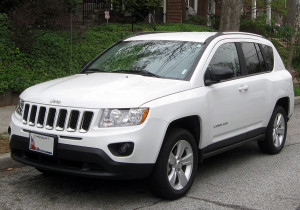 2007, 2008, 2009, 2010, 2011, 2012, 2013, 2014, 2015, 2016 Jeep Compass
2007, 2008, 2009, 2010, 2011, 2012, 2013, 2014, 2015, 2016 Jeep Compass
Guaranteed 3 across installations:
Clek Fllo (x3).
Clek Foonf (x3).
Diono Radian RXT (x3).
Diono Radian R120 (x3).
Diono Radian R100 (x3).
Combi Coccoro (x3).
Clek Fllo, Diono Radian / RXT, Diono Radian / RXT.
Clek Fllo, Graco Size4Me 65, Diono Radian / RXT.
Chicco KeyFit 30, Clek Fllo, Chicco KeyFit 30.
Tips and Tricks:
There is only one generation of the Jeep Compass so far, and it’s 173 inches long and slightly more than 69 inches wide. In other words, it’s about the width and length of a small car, although it sits significantly higher than one. That said, despite its size, you’ll still be able to stuff a range of car seats into it if you’re willing to take your time and use the seat belts. Using LATCH will only frustrate you when working with a vehicle this narrow side-to-side.
Because of the length of the vehicle, if you want to make the most of your money, I’d strongly recommend Radians due to the minimal amount of space they take up with angle adjusters; your legs and front-row passengers will thank you.
—
If you find the information on car safety, recommended car seats, and car seat reviews on this car seat blog helpful, you can shop through this Amazon link for any purchases, car seat-related or not. Canadians can shop through this link for Canadian purchases.

